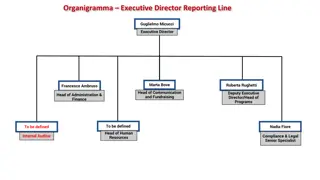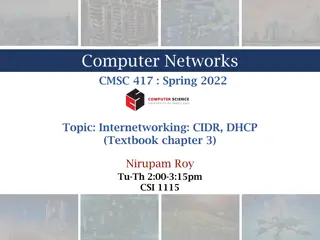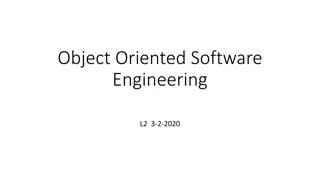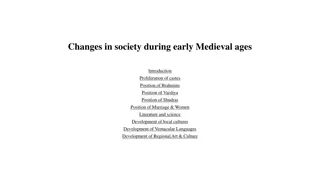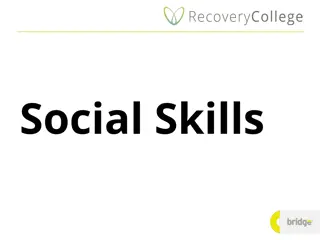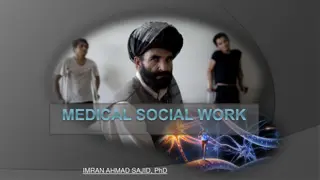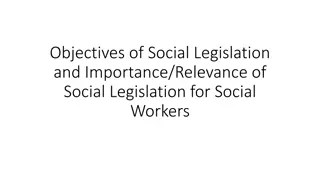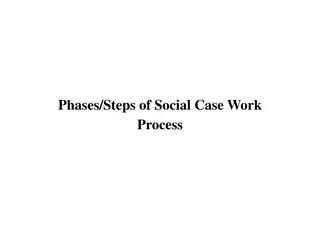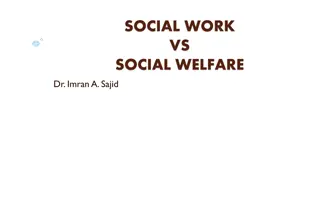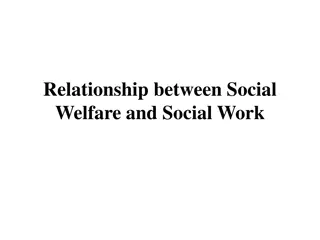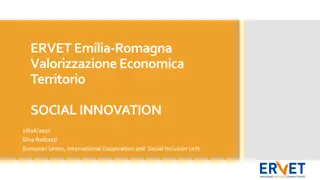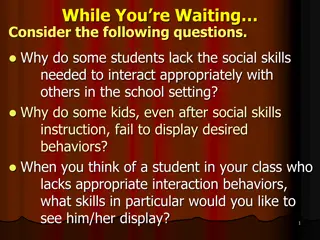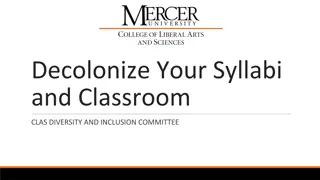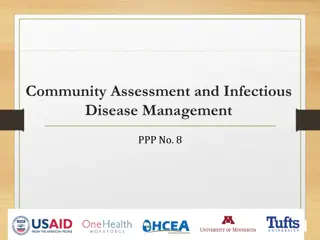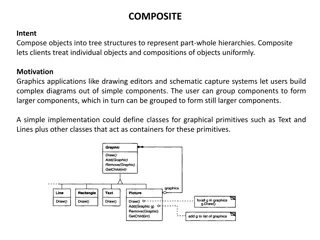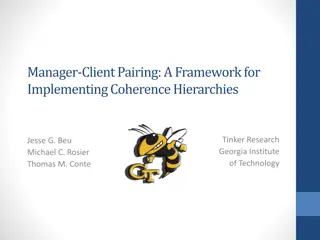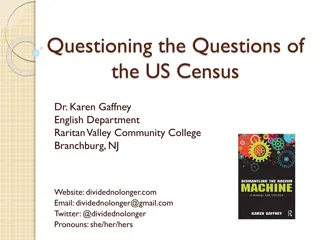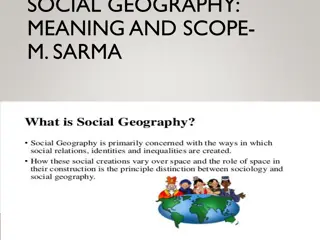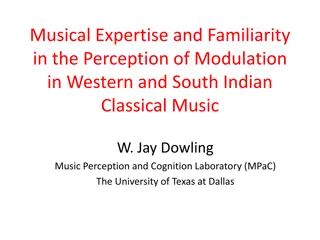Organizational Structure of a Nonprofit Organization
Detailed organigrams showcasing the reporting lines and roles within a nonprofit organization led by Executive Director Guglielmo Micucci. The structure includes departments like Communication & Fundraising, Human Resources, Administration & Finance, and Digital & Social Units, each headed by compet
0 views • 12 slides
Computer Networks CMSC 417 : Spring 2022
Exploring the concepts of Classless Interdomain Routing (CIDR) and Dynamic Host Configuration Protocol (DHCP) in the context of internetworking. CIDR simplifies subnetting by allowing for classless addressing, hiding network hierarchies, and enabling supernetting. Lessons learned from subnetting inc
0 views • 57 slides
Understanding Social Entrepreneurship, Social Enterprise, and Social Innovation
Social entrepreneurship involves creating sustainable social impact, social enterprises address challenges in critical needs sectors, and social innovation focuses on developing effective solutions to social and environmental issues. These concepts emphasize creating social value while engaging with
2 views • 19 slides
Understanding Object-Oriented Software Engineering Principles
Explore the concepts of inheritance, generalization/specialization, UML representation, object/class relationships, multiplicity notations, and aggregation in object-oriented software engineering. Learn how methods and attributes can be inherited, grouped, and reused among classes, and understand th
0 views • 30 slides
Exploring Metrical Phonology: A Brief Overview
Metrical phonology, a subtheory of generative phonology, focuses on categorizing stress and stress rules within rhythmic hierarchies. It differs from generative phonology by not treating stress as a segmental feature specific to vowels. Originating from Halle's linear analysis, metrical stress theor
1 views • 32 slides
Policy Paper as Mode of Assessment in Modern Languages and Cultures
Policy papers are essential tools for communicating research findings and recommendations to policy actors. This assessment at Durham University involves writing a short policy paper aimed at a broad audience, focusing on a specific social issue. The process includes dissecting various parts of the
0 views • 9 slides
Understanding OSI Model and TCP/IP Protocol Suite
Explore the concept of layering in data communication, comparing the OSI model and TCP/IP protocol suite. Learn about protocol layers, protocol hierarchies, and the functionality of each layer in these models. Discover the interrelationships between layers and the evolution from OSI to TCP/IP.
5 views • 57 slides
Analysis of Dario Fo's "Accidental Death of an Anarchist
Dario Fo's play "Accidental Death of an Anarchist" explores themes of police corruption, government collusion, and the suspicious death of an anarchist in police custody. The play delves into issues of impersonation, infiltration, and double-talk, shedding light on societal corruption and manipulati
0 views • 7 slides
Social Changes in Early Medieval India: Caste Proliferation and Hierarchies
Social changes during the early Medieval ages in India were shaped by economic developments, leading to the proliferation of castes and shifts in the positions of Brahmins, Vaishyas, and Shudras. The Brahmins held the highest social position, while Vaishyas were marginalized. The period also saw the
0 views • 11 slides
Understanding the Importance of Social Skills for Mental Health Recovery
Social skills play a crucial role in how we communicate, interact, and form relationships with others. They are essential for personal, social, and professional success. Neglecting social skills can hinder mental health recovery, as they contribute to social recognition, acceptance, and building soc
2 views • 12 slides
Understanding Medical Social Work and Its Impact on Patient Well-being
Medical Social Work, also known as Health Care Social Work, plays a crucial role in addressing the social, physical, and psychological needs of patients. Through providing case work, after-care, and convalescence services, Medical Social Workers contribute to reducing hospital readmissions, preventi
0 views • 12 slides
Technology-Enabled Visitor Experiences in Tourism
This material delves into the vital role of Information Technology in attracting visitors to attractions and events. It explores the various ways IT enhances visitor experiences through disruptive and moderating methods, providing insight into the management of visitors in attraction and event setti
0 views • 23 slides
AP World History Interactions in Early Urban Societies
Interactions in early urban societies, as depicted in inscriptions, provide insights into the development of trade networks, social hierarchies, and religious influences. Questions explore the context of inscriptions, social norms, and religious practices during specific historical periods.
0 views • 8 slides
Objectives and Importance of Social Legislation for Social Workers
Social legislation is inspired by the constitution and aims to remove discrimination, safeguard rights of vulnerable groups, and eradicate social evils. It plays a crucial role in social welfare by providing a legal basis for addressing societal issues, enhancing community well-being, and facilitati
0 views • 4 slides
Phases and Steps of Social Case Work Process
Social case work process involves three main phases: Social Study, Social Diagnosis, and Social Treatment. The Social Study phase focuses on acquiring facts about the client's situation, while Social Diagnosis involves the professional opinion of the case worker towards a solution. Social Treatment
0 views • 7 slides
Mapping Methodology for Establishing ESCO Relations
Learn how to set up teams, collect resources, compare classifications, and establish mapping relations for ESCO implementation projects. Get insights on using computer-assisted suggestions, updating mapping tables, and selecting mapping projects. Explore techniques for navigating classifications, br
1 views • 21 slides
Understanding the Difference Between Social Work and Social Welfare
Social work and social welfare are often used interchangeably, but there are distinct differences between the two. Social work involves highly trained professionals providing services to individuals and communities in need, using problem-solving methods. On the other hand, social welfare focuses on
0 views • 9 slides
Understanding the Relationship Between Social Welfare and Social Work
Social welfare and social work are interconnected concepts aimed at enhancing societal well-being. Social welfare refers to a nation's system of programs and services meeting essential needs, while social work involves professional activities supporting individuals and communities in achieving socia
0 views • 6 slides
Understanding H5 Files: A Practical Overview
H5 files, which stand for Hierarchical Data Format 5, store data in a structured manner, commonly used for storing weights in machine learning models. Exploring the contents of H5 files and dealing with unknown hierarchies can be challenging but essential tasks in data analysis. This presentation pr
0 views • 8 slides
Insights into Cultural Competence in Healthcare Settings
Explore the importance of cultural competence in healthcare through topics such as adapting to clinical and communication differences, understanding patient expectations, and building trust across diverse backgrounds. Learn how NHS professionals navigate hierarchies, challenges in authority, and the
1 views • 10 slides
Understanding Social Hierarchies in Animal Behavior
Social behavior in animals involves living in social groups, establishing social hierarchies, and exhibiting dominance behaviors. Animals have developed various signals and behaviors to interact successfully within these groups. Social hierarchies offer advantages such as increased chances of surviv
1 views • 20 slides
Social Economy and Innovation in Emilia-Romagna Region
Emilia-Romagna Region in Italy highlights the importance of social economy and innovation for sustainable development. Various initiatives such as Social Cooperatives and Voluntary Associations contribute to the region's social well-being. The focus on social values and not-for-profit activities dri
1 views • 15 slides
Understanding Social Skills Development in Students
Explore the reasons behind students lacking social skills in school settings and analyze the challenges some face even after receiving social skills instruction. Discover the key social skills required for appropriate interactions and the importance of social competence for overall well-being. Delve
0 views • 64 slides
Understanding Logistic Regression in Multi-level Hierarchies
Explore the intricacies of logistic regression in cross-level hierarchies through helpful project advice, model graphs, and leftover considerations. Learn about transforming binary responses, interpreting log-odds, and conducting multilevel logistic regression with random intercepts. Dive into real-
0 views • 21 slides
Decolonize Your Syllabi and Classroom Workshop Overview
Explore the importance of decolonizing your syllabi and classroom to create inclusive environments. Understand the core concepts of diversity, inclusion, and decolonization in education. Learn how to rethink and reconstruct your course to amplify diverse voices and challenge colonial hierarchies. Di
0 views • 9 slides
Understanding R&D Internationalization through Firm and Patent Data Analysis
Explore the measurement of R&D internationalization by analyzing firm and patent data. Traditional and recent approaches, including combining firm and patent data, offer insights into foreign R&D activities. The International Hierarchical Ownership Model (IHOM) provides a longitudinal view of MNC ow
0 views • 34 slides
Evolution of Etiquette: From Historical Customs to Modern Standards
Explore the evolving nature of etiquette, which has transitioned from rigid social hierarchies to a more inclusive and considerate set of guidelines reflecting changing societal norms. Etiquette serves as a means to show respect and consideration to others, emphasizing the importance of good behavio
1 views • 62 slides
Exploring Raciolinguistics in Medical Spanish Education
Delve into the intersection of racism, linguistics, and medical Spanish education to enhance care for linguistic minorities with equity. Understand raciolinguistic perspectives, apply language & race concepts to teaching communication skills, evaluate curricular materials for raciolinguistic hierarc
0 views • 11 slides
Understanding the Composite Design Pattern in Object-Oriented Programming
The Composite design pattern allows clients to treat individual objects and compositions of objects uniformly, enabling the representation of part-whole hierarchies in tree structures. This pattern is commonly used in graphics applications to create complex diagrams from simple components, allowing
0 views • 43 slides
Understanding Social Neuroscience: Exploring Human Sociality and Well-Being
Social neuroscience delves into how the brain processes social interactions and their impact on human well-being. It focuses on the interconnectedness between social connections and overall life satisfaction, suggesting that humans are inherently social beings with a strong need for social belonging
2 views • 21 slides
Tradeoffs in Coherent Cache Hierarchies for Accelerators
Explore the design tradeoffs and implementation details of coherent cache hierarchies for accelerators in the context of specialized hardware. The presentation covers motivation, proposed design, evaluation methods, results, and conclusions, highlighting the need for accelerators and considerations
0 views • 22 slides
Social Entrepreneurship and Social Inclusion in Bulgaria
The development and implementation of social entrepreneurship practices in Bulgaria aim to promote social inclusion through the development of the social economy. The focus is on combining economic results with social objectives, managed transparently with measurable, positive financial value. Vario
2 views • 12 slides
Efficient Manager-Client Pairing for Coherence Hierarchies
Addressing the challenges in designing and integrating coherence protocols, this framework emphasizes using existing protocols as building blocks for heterogeneous hierarchies. The Manager-Client Pairing approach enables efficient communication, action types, and usage of tier width and hierarchy he
0 views • 18 slides
Hierarchical Semi-Supervised Classification with Incomplete Class Hierarchies
This research explores the challenges and solutions in semi-supervised entity classification within incomplete class hierarchies. It addresses issues related to food, animals, vegetables, mammals, reptiles, and fruits, presenting an optimized divide-and-conquer strategy. The goal is to achieve semi-
0 views • 18 slides
Diverse Social Entities Mining from Linked Data in Social Networks
This research focuses on mining diverse social entities from linked data in social networks using a DF-tree structure and DF-growth mining algorithm. The study explores the extraction of important linked data in social networks and the mining of various social entities such as friends. Prominence va
0 views • 13 slides
Unpacking the Historical Relationship Between the US Census and Race
Dr. Karen Gaffney from Raritan Valley Community College delves into the complex historical ties between the US Census and race, exploring how categorization influenced social hierarchies and citizenship. She questions past practices, offering insights into future census considerations. The session h
0 views • 23 slides
Basic Principles of Inheritance in Information Systems
Understanding inheritance in information systems is crucial for designing efficient architectures. This chapter delves into the principles of inheritance, such as attribute and method inheritance, generalization, and subtype hierarchies. It also discusses the modeling of inheritance through UML nota
0 views • 71 slides
Understanding Social Geography: Meaning, Scope, and Differences
Social geography is a branch of human geography focusing on social structures, groups, and activities. It examines the spatial arrangement of social phenomena, social differences, and patterns in understanding socially defined population groups. The scope of social geography includes analyzing spati
0 views • 25 slides
Understanding Modulation and Tonal Hierarchies in Music Perception
This research explores how expertise influences the perception of modulation in Western and South Indian classical music, focusing on tonal hierarchies, pitch importance, modulation processes, and memory for melodies. Through experiments involving listeners rating probe tones against music excerpts,
1 views • 26 slides
Hierarchical Body Modeling in OpenGL Homework 3
Explore the concepts of hierarchical body modeling in OpenGL Homework 3 by creating body part hierarchies, recording transformation matrices, and understanding the hierarchy structures. The homework focuses on building hierarchies for body parts like thighs and shanks, applying transformations, and
0 views • 23 slides
